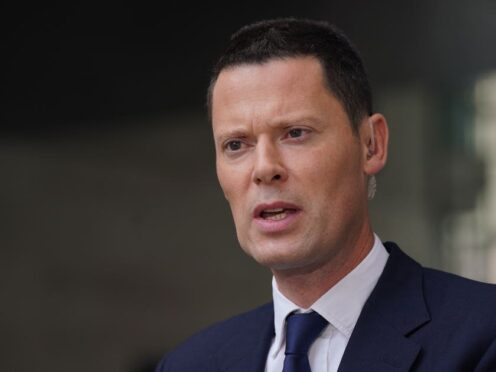
A move to potentially allow prisoners to shave two months off their jail time is the “most drastic form of early release” ever witnessed in England and Wales, according to Labour.
Justice Secretary Alex Chalk on Monday announced an extension to the end of custody supervised licence (ECSL) scheme, taking it from 18 days to a maximum of 60 days in a bid to ease overcrowding pressures in prisons.
The Conservative UK Government has insisted the measure will be temporary and only apply to so-called “low-level offenders”.
Mr Chalk made the announcement via a written ministerial statement to Parliament after 8pm, a situation Labour branded “plainly inadequate given the gravity of the situation”, before attending the Commons in person on Tuesday to update MPs.

Shabana Mahmood, the shadow justice secretary, said the extension was “unprecedented”.
Replying to Mr Chalk’s statement in the Commons, she said: “Let us be in no doubt, this is the most drastic form of early release for prisoners that this country has ever seen, and in his 11-page and 10-minute long statement today, it merited one paragraph.
“This is a measure which will cause shockwaves and deep concern across our country, and the Secretary of State seems to think a quiet written ministerial statement published late last night and one paragraph today is good enough — it is not.”
The Labour MP posed a number of questions for her opposite number, including how many people had so far been released via the scheme, what prisons are making use of it and whether convicted domestic abusers and stalkers are eligible under its terms.
Ms Mahmood added: “The Government has refused all requests to be transparent about the scale and the impact of this scheme, this is no way to run the criminal justice system, or indeed the country.”

Mr Chalk did not provide answers to her questions but assured that the Government would take “every step to protect the public”.
The Cabinet minister said there would be safeguards in place, including a gold command veto that would mean if a prison governor has “concerns about safety, then that person will not be released”.
The Justice Secretary announced in October that the Government would use the powers it has to allow the prison service to let some prisoners out of jail up to 18 days early to ease overcrowding.
But with recent Ministry of Justice (MoJ) statistics showing that prisons in England and Wales are still nearing capacity, Mr Chalk opted on Monday to extend ECSL measures “to around 35-60 days”.
The MoJ said that prisons would have licence to release eligible offenders up to 35 days before their prison tenure is due to end, with the provision to extend that further to 60 days if necessary in the future.
Downing Street said the scheme would be temporary but refused to set a deadline for when it would be wound down.
The early release scheme has been mired in opacity since the very beginning.
Today, I have written to @AlexChalkChelt to demand answers on why the Government has expanded the scheme to an unprecedented 60 days.
The Justice Secretary has a duty to be candid with the public. pic.twitter.com/XhcqNWGqUQ
— Shabana Mahmood MP (@ShabanaMahmood) March 12, 2024
Asked how long it could be in place, Prime Minister Rishi Sunak’s official spokesman said: “I can’t offer a projection but it is very clearly a temporary measure.
“It is up to governors to use it operationally, depending on their circumstances.”
According to MoJ figures, the prison population stood at 88,220 as of March 8.
The operational capacity is a little over 89,000.
Prisons charity the Howard League states that the prison estate should not hold more than 79,597 people.
Labour MP Andy Slaughter told the Justice Secretary that, on a visit to HMP Wormwood Scrubs in west London with prisons minister Edward Argar, they saw “doubling up in single cells with unshielded toilets” and “overcrowding affecting time out of cell and access to work”.
Mr Chalk blamed overcrowding on a mix of factors, including criminals serving longer sentences under tougher punishment laws and the refusal to follow other countries’ lead by freeing low-risk prisoners during the coronavirus pandemic.
He said other policies being enacted by ministers to tackle prison numbers included deporting more foreign criminals and increasing the availability of bail hearings.
The senior Tory said the Government would “radically change” the way it deals with foreign national offenders (FNOs) to free up space in prisons, with 400 additional caseworkers appointed to “prioritise these cases”.
The Justice Secretary said he was building on reforms he set out in the autumn, including extending the early removal scheme from a maximum period of 12 months to 18 months “so that eligible FNOs can be deported up to six months earlier”.
Mr Chalk said almost 400 FNOs have already been removed from the UK since January as a result, adding that a “robust new agreement with Albania” and plans in the Criminal Justice Bill to rent prisons overseas would also help.
According to Mr Chalk, there are more than 10,000 foreign criminals in the prison system, making up 12% of prisoners in England and Wales and costing the taxpayer on average £50,000 per year.

Enjoy the convenience of having The Sunday Post delivered as a digital ePaper straight to your smartphone, tablet or computer.
Subscribe for only £5.49 a month and enjoy all the benefits of the printed paper as a digital replica.
Subscribe